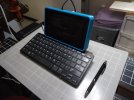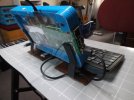I've been struggling a lot with writing as of late and all the distractions of our modern world and lifestyles surrounded by gadgets and things pushing us with ragebait, doomscroll fodder and empty entertainment has not helped. So a while ago I set myself the task of building a setup with absolutely no distractions so I could finally get cracking on writing a novel that's been on the backburner of the minutae of life for quite a while now.
Knowing myself, I knew I needed a system that couldn't offer me any distractions and the project started with my getting a 20+ year old laptop with a nice keyboard that simply could not run modern internet or any such shenanigans. I experimented with a lot of OS's to put in it, but even the lightest of Linux environments were bogged down by the CPU and mere 1Gb of memory. FreeBSD, no such problems. Haiku also ran pretty nice... too nice. I could access the internet, so it was a no-go. I was happy for a bit.
But it wasn't perfect. Even though the laptop had a nice keyboard, it couldn't compete with a proper mechanical keyboard in its typing comfort, so I decided to build it around a Raspberry Pi instead. The big thing about the distraction free environment is that I don't want to run any GUI. It's kind of weird to me that people spend money on distraction free writers for the desktop when the distractions pretty much vanish if you ditch the desktop altogether. I've had issues trying to run FreeBSD with a WM on the underpowered RPi4+ before, so that's perfect. Also the perfect distraction free writing environment for me: VIM. And RPi4b has no problems flying on the command line running VIM.
My big issue was finding the perfect monitor. Small monitors are really hard to come by these days, until I found this absolute unit for mere 20€ from a local IT supplier. I might've made a mistake by installing bsdgames, but they're not too distracting and I can always uninstall if need be. Other than that, I'm really happy with this setup. I've been working through the outline for the novel with ease and I highly recommend a setup like this if you're a writer in search of a really good focused environment.
I have a few plugins for VIM that make prose writing a breeze and as hard as it might be to believe, this is a pretty riced command line since I've done a lot of modifications to make it as easy as possible to use. It's not perfect, but by far the best writing environment I have. If somebody's interested, I can share my dotfiles, but it's not hard to do and I recommend everyone doing a software setup that's perfect for them.
Next up: make this into a cyberdeck. For that I've ordered an e-ink display and I'm planning to actually experiment with RISC-V for the lols.

Knowing myself, I knew I needed a system that couldn't offer me any distractions and the project started with my getting a 20+ year old laptop with a nice keyboard that simply could not run modern internet or any such shenanigans. I experimented with a lot of OS's to put in it, but even the lightest of Linux environments were bogged down by the CPU and mere 1Gb of memory. FreeBSD, no such problems. Haiku also ran pretty nice... too nice. I could access the internet, so it was a no-go. I was happy for a bit.
But it wasn't perfect. Even though the laptop had a nice keyboard, it couldn't compete with a proper mechanical keyboard in its typing comfort, so I decided to build it around a Raspberry Pi instead. The big thing about the distraction free environment is that I don't want to run any GUI. It's kind of weird to me that people spend money on distraction free writers for the desktop when the distractions pretty much vanish if you ditch the desktop altogether. I've had issues trying to run FreeBSD with a WM on the underpowered RPi4+ before, so that's perfect. Also the perfect distraction free writing environment for me: VIM. And RPi4b has no problems flying on the command line running VIM.
My big issue was finding the perfect monitor. Small monitors are really hard to come by these days, until I found this absolute unit for mere 20€ from a local IT supplier. I might've made a mistake by installing bsdgames, but they're not too distracting and I can always uninstall if need be. Other than that, I'm really happy with this setup. I've been working through the outline for the novel with ease and I highly recommend a setup like this if you're a writer in search of a really good focused environment.
I have a few plugins for VIM that make prose writing a breeze and as hard as it might be to believe, this is a pretty riced command line since I've done a lot of modifications to make it as easy as possible to use. It's not perfect, but by far the best writing environment I have. If somebody's interested, I can share my dotfiles, but it's not hard to do and I recommend everyone doing a software setup that's perfect for them.
Next up: make this into a cyberdeck. For that I've ordered an e-ink display and I'm planning to actually experiment with RISC-V for the lols.


